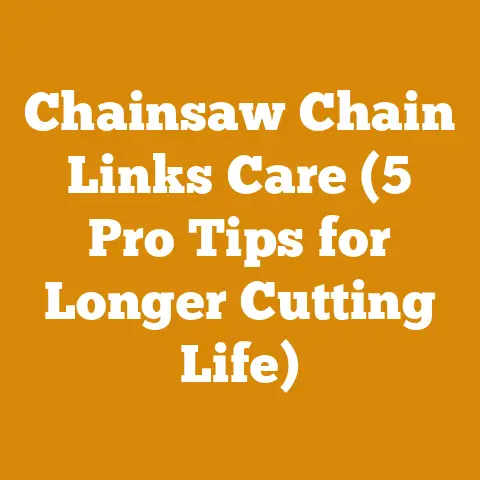Average Stump Grinding Cost (5 Pro Tips for Accurate Pricing)
Let’s face it, dealing with tree stumps is a pain.
They’re unsightly, they take up valuable space, and they can even be a safety hazard.
But figuring out exactly what you’ll pay for the service can feel like navigating a dense forest.
That’s why I’ve put together this guide to help you understand the average stump grinding cost and give you five pro tips for getting the most accurate pricing.
I’ve spent years working with wood, from felling trees in the forests of the Pacific Northwest to running a small firewood business in the Midwest.
I’ve seen firsthand how crucial it is to manage every aspect of the job, including those pesky stumps left behind.
I’ll share my experiences and insights to help you avoid overpaying and ensure you get the job done right.
Understanding Stump Grinding Costs: An Overview
Stump grinding costs can vary widely depending on several factors.
It’s not as simple as getting a single price quote and running with it.
Here’s a general overview to help you get started:
- Average cost per stump: Expect to pay anywhere from $75 to $400 per stump.
Smaller stumps (under 12 inches in diameter) might be on the lower end, while larger stumps (over 36 inches) will be significantly more. - Hourly rates: Some companies charge hourly rates, which can range from $100 to $200 per hour.
This is often the preferred method for larger jobs with multiple stumps. - Diameter matters: The diameter of the stump is the most significant factor affecting the price.
A 12-inch stump will cost less to grind than a 36-inch stump. - Accessibility: If the stump is difficult to access (e.g., behind a fence, on a steep slope), the price will likely increase.
- Location: Prices can vary depending on your geographic location.
Metropolitan areas tend to have higher prices due to increased operating costs. - Additional services: Some companies include services like debris removal and surface root grinding in their price, while others charge extra.
5 Pro Tips for Accurate Stump Grinding Pricing
1. Get Multiple Quotes and Compare Apples to Apples
This is the golden rule.
Never settle for the first quote you receive.
Contact at least three different stump grinding companies and get detailed estimates.
But don’t just focus on the bottom line.
Make sure you’re comparing the same services.
- Ask for a breakdown: Request a detailed breakdown of the costs.
Is debris removal included?
What about surface root grinding?
How deep will they grind the stump? - Inquire about hidden fees: Ask about any potential hidden fees or extra charges.
For example, some companies might charge extra for stumps that are close to underground utilities. - Check for insurance and licensing: Ensure that the companies you’re considering are properly insured and licensed.
This protects you in case of accidents or property damage.
My Experience: I once hired a stump grinder who gave me a lowball quote but then tried to charge extra for debris removal.
I had to negotiate the price down, which was a hassle.
From that day on, I always get detailed quotes in writing.
2. Understand the Diameter Measurement
The diameter of the stump is the primary factor influencing the cost.
It’s crucial to understand how companies measure diameter to ensure you’re getting an accurate estimate.
- Measure at the widest point: The diameter should be measured at the widest point of the stump, near ground level.
- Don’t estimate: Don’t guess the diameter.
Use a measuring tape to get an accurate measurement. - Take pictures: Take pictures of the stump with a measuring tape alongside it.
This provides proof of the diameter and can help avoid disputes later on.
Wood Science Insight: Remember that the diameter of the stump doesn’t always correlate directly with the size of the tree that was removed.
Factors like tree species, growth rate, and age can all affect the stump’s size.
3. Assess the Accessibility of the Stump
Accessibility plays a significant role in determining the cost.
If the stump is difficult to reach, the company will need to spend more time and effort to grind it, which will increase the price.
- Identify obstacles: Note any obstacles that might hinder access, such as fences, walls, or steep slopes.
- Consider the terrain: Is the ground soft or uneven?
This can make it difficult to maneuver the stump grinder. - Communicate clearly: Clearly communicate any accessibility challenges to the stump grinding companies when requesting quotes.
My Insight: I had a stump in my backyard that was behind a narrow gate.
The stump grinding company had to use a smaller, more expensive grinder, which increased the price.
If I had removed the gate beforehand, I could have saved some money.
4. Negotiate the Price and Look for Discounts
Don’t be afraid to negotiate the price.
Stump grinding companies are often willing to offer discounts, especially if you have multiple stumps to grind or if you’re a repeat customer.
- Bundle services: If you have other tree care services you need, such as tree trimming or removal, try to bundle them together for a discount.
- Ask about seasonal discounts: Some companies offer discounts during the off-season (e.g., winter) when demand is lower.
- Compare quotes: Use the quotes you’ve received from other companies as leverage to negotiate a better price.
Case Study: A friend of mine had three large stumps in his yard.
He got quotes from several companies and was able to negotiate a 15% discount by playing them off against each other.
5. Consider DIY Stump Grinding (With Caution)
If you’re on a tight budget, you might consider renting a stump grinder and doing the job yourself.
However, this is not a decision to be taken lightly.
- Rental costs: Stump grinders can be rented from equipment rental companies for around $100 to $300 per day.
- Safety concerns: Stump grinding is dangerous work.
You’ll need to wear appropriate safety gear, including eye protection, ear protection, and gloves. - Skill level: Operating a stump grinder requires skill and experience.
If you’re not comfortable using heavy machinery, it’s best to leave it to the professionals. - Time commitment: Grinding a stump can take several hours, depending on its size and accessibility.
My Recommendation: Unless you have experience operating heavy machinery and are comfortable with the safety risks, I recommend hiring a professional.
The cost savings might not be worth the risk of injury or property damage.
Diving Deeper: The Science Behind Stump Grinding
Beyond the practical tips, understanding the science behind wood and stump grinding can help you appreciate the process and make informed decisions.
Wood Anatomy and Properties
The type of wood in the stump affects how easily it can be ground.
Hardwoods like oak and maple are denser and more difficult to grind than softwoods like pine and fir.
- Hardwood vs.
Softwood: Hardwoods have a more complex cellular structure, making them more resistant to abrasion.
Softwoods, on the other hand, have a simpler structure and are easier to cut and grind. - Moisture Content: The moisture content of the stump also affects its grindability.
A freshly cut stump will be easier to grind than a dry, seasoned stump.
The higher the moisture content, the “softer” the wood will be. - Decomposition: Over time, stumps will naturally decompose.
This decomposition process can make them easier to grind, but it can also attract pests and diseases.
Stump Grinder Mechanics
Stump grinders use a high-speed rotating wheel with teeth to chip away at the wood.
The teeth are typically made of tungsten carbide, which is extremely hard and durable.
- Tooth Design: The design of the teeth affects the efficiency of the grinding process.
Some teeth are designed for aggressive cutting, while others are designed for smoother finishing. - Wheel Speed: The speed of the rotating wheel is measured in RPM (revolutions per minute).
Higher RPMs generally result in faster grinding. - Engine Power: The engine power of the stump grinder determines how much force it can apply to the wood.
More powerful grinders can handle larger stumps and denser wood.
Safety Considerations
Stump grinding is inherently dangerous due to the high-speed rotating wheel and flying debris.
It’s crucial to take safety precautions to protect yourself and others.
- Personal Protective Equipment (PPE): Always wear eye protection, ear protection, gloves, and sturdy footwear when operating a stump grinder.
- Clear the Area: Clear the area around the stump of any obstacles, such as rocks, branches, or debris.
- Keep Bystanders Away: Keep bystanders at least 50 feet away from the stump grinder.
- Inspect the Machine: Before operating the stump grinder, inspect it for any damage or wear.
- Follow Instructions: Always follow the manufacturer’s instructions for operating the stump grinder.
Project Planning and Execution
Step-by-Step Guide
- Assessment: Evaluate the stump(s) for size, accessibility, and proximity to utilities.
- Research: Research local stump grinding companies and read reviews.
- Quotes: Obtain at least three detailed quotes from different companies.
- Negotiation: Negotiate the price and clarify any questions or concerns.
- Scheduling: Schedule the stump grinding service at a convenient time.
- Preparation: Prepare the area around the stump by removing any obstacles.
- Execution: Supervise the stump grinding process and ensure it’s done to your satisfaction.
- Cleanup: Clean up any debris and fill the hole with soil.
Post-Grinding Considerations
After the stump has been ground, you’ll need to decide what to do with the resulting hole.
- Filling the Hole: The most common option is to fill the hole with soil and plant grass or flowers.
- Using the Wood Chips: The wood chips can be used as mulch in your garden or composted.
- Dealing with Roots: Surface roots can be ground down as well, but this will add to the cost.
Case Studies: Real-World Examples
Let’s look at a few real-world examples to illustrate how these tips can be applied.
Case Study 1: The Overgrown Backyard
Problem: A homeowner had two large oak stumps in their backyard that were difficult to access due to overgrown bushes and a narrow gate.
Solution: The homeowner cleared the bushes and removed the gate to improve accessibility.
They then obtained quotes from three different companies and negotiated a lower price by bundling the stump grinding service with tree trimming.
Result: The homeowner saved money and was able to reclaim their backyard.
Case Study 2: The DIY Disaster
Problem: A homeowner decided to rent a stump grinder and do the job themselves to save money.
However, they had no experience operating heavy machinery and ended up damaging their fence and injuring their foot.
Solution: The homeowner called a professional stump grinding company to finish the job.
Result: The homeowner ended up spending more money than they would have if they had hired a professional in the first place.
Case Study 3: The Negotiating Ninja
Problem: A homeowner had four small pine stumps in their front yard.
Solution: The homeowner obtained quotes from several companies and used the lowest quote as leverage to negotiate a discount with their preferred company.
They also asked about seasonal discounts and were able to get an additional 10% off.
Result: The homeowner saved a significant amount of money by negotiating effectively.
Stump Grinding in 2024: Current Trends and Statistics
In 2024, the stump grinding industry continues to evolve, with new technologies and trends emerging.
- Electric Stump Grinders: Electric stump grinders are becoming increasingly popular due to their quiet operation and zero emissions.
- Remote-Controlled Stump Grinders: Remote-controlled stump grinders allow operators to work from a safe distance, reducing the risk of injury.
- GPS Technology: GPS technology is being used to map and track stump locations, improving efficiency and accuracy.
- Industry Statistics: According to recent industry reports, the stump grinding market is expected to grow by 5% annually over the next five years.
Conclusion: Taking the Next Steps
Removing tree stumps is a necessary part of landscaping and property maintenance.
By understanding the factors that affect stump grinding costs and following these pro tips, you can get the most accurate pricing and avoid overpaying.
Whether you choose to hire a professional or tackle the job yourself, remember to prioritize safety and plan carefully.
Here’s a quick recap of the key takeaways:
- Get multiple quotes and compare apples to apples.
- Understand the diameter measurement.
- Assess the accessibility of the stump.
- Negotiate the price and look for discounts.
- Consider DIY stump grinding (with caution).
Now that you’re armed with this knowledge, you can confidently approach your stump grinding project and get the job done right.
Good luck!






